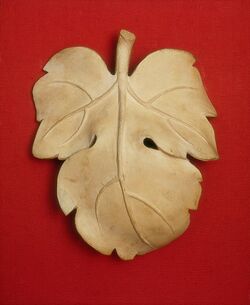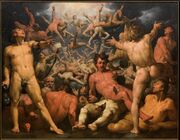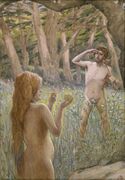Religion:Fig leaf

In culture, a "fig leaf" or "fig-leaf" is a literal or figurative method of obscuring an act or object considered embarrassing or distasteful with something of innocuous appearance. The use of an actual fig leaf for the purpose originates in Western painting and sculpture, where leaves would be used by the artist themselves or by later censors in order to hide the genitalia of a subject. Use of the fig plant in particular came about as a Biblical reference to the Book of Genesis, in which Adam and Eve used fig leaves to cover their nudity after eating the forbidden fruit from the tree of the knowledge of good and evil.[2][3]
A "fig-leaf edition" of a work is known as an expurgation or Bowdlerization.
History
Ancient Greek art was dominated by the tradition of heroic nudity and a more general normalization of male nakedness, including the genitals, although the female vulval area was generally covered in art for public display. This tradition continued in Ancient Roman art until the conversion of the Roman Empire to Christianity, when such practices vanished entirely. During the Middle Ages, only the unfortunate (most often the damned) were usually shown naked, although the depictions were then often rather explicit.[4] Adam and Eve were often shown wearing fig or other leaves, following the Biblical description. This was especially a feature of Northern Renaissance art.

From about 1530, the developing reaction to Renaissance freedoms and excesses that led to the Council of Trent also led to a number of artworks, especially in churches or public places, being altered to reduce the amount of nudity on display. Often, as in the famous case of Michelangelo's The Last Judgement, drapery or extra branches from any nearby bush was used. This has been dubbed the "fig leaf campaign".[citation needed] For free-standing statues this did not work well, and carved or cast fig leaves were sometimes added, such as with the plaster copy of Michelangelo's David displayed in Victorian era London.[5] In the reign of Queen Victoria, display of male nudity was contentious and the Queen herself was said to find it shocking. The museum commissioned this fig leaf and kept it in readiness in case of a visit by the Queen or other female dignitaries: the fig leaf was then hung on the figure using a pair of hooks.[6] Historian Daniel J. Boorstin said that:
The age of the rising middle class in Victorian England was, or course, the age of the fig leaf. "The fig leaves of decent reticence" which Charles Kingsley described were applied not only to statuary but to literature as well.[7]
The Adam and Eve panels on the Ghent Altarpiece, already equipped with fig leaves by Jan van Eyck, were simply replaced with 19th-century panels copying the figures but clothed. Many of these alterations have since been reversed, damaging some of the statues.
Eugen Sandow, often considered the first modern-day bodybuilder, was an admirer of the masculine physique, encapsulated in a Greco-Roman musculature he termed the Grecian Ideal. In addition to strongman sideshows, he performed "muscle displays" by posing in the nude—save for a fig leaf that he would don in further emulation of statues he described seeing in Italy as a boy.[8]
Modern era
The expression fig leaf has a pejorative metaphorical sense meaning a flimsy or minimal cover for anything or behaviour that might be considered shameful, with the implication that the cover is only a token gesture and the truth is obvious to all who choose to see it.[9]
A metaphorical fig leaf is something visible but innocuous, as against a coverup in which the existence of something may be entirely hidden. In the context of negotiation, an offer might be characterized as a "fig leaf" if that offer is actually a ploy to conceal a sinister plan.[citation needed]
Gallery
-
The Expulsion from the Garden of Eden, by Masaccio, before and after restoration. It was painted in 1425, covered up in 1680, and restored in 1980.
-
The Fall of the Titans by Cornelis Cornelisz. van Haarlem
-
Perseus and Andromeda, fig leaf copy of original relief work
-
Adam is Tempted by Eve by James Tissot
See also
- Censorship
- Religion and sexuality
- Christian naturism
- Olive branch
Citations
- ↑ "Fig-leaf for Michelangelo's David". Collections. V&A Museum. http://www.vam.ac.uk/content/articles/d/davids-fig-leaf/.
- ↑ Genesis 3:7. WikiSource. "...and they sewed fig leaves and made themselves waist-belts"
- ↑ "Genesis 3:7 (several translations)". https://www.biblegateway.com/verse/en/Genesis%203%3A7.
- ↑ Clark, Kenneth (1956). The Nude, A Study in Ideal Form. Princeton University Press. ISBN 0-691-01788-3. https://archive.org/details/nudestudyinideal00clar.
- ↑ "David's Fig Leaf". Victoria & Albert Museum. http://www.vam.ac.uk/collections/sculpture/stories/david/index.html.
- ↑ "Fig-leaf for Michelangelo's David". Collections. V&A Museum. http://www.vam.ac.uk/content/articles/d/davids-fig-leaf/.
- ↑ Boorstin, Daniel J. (1962). The Image: A Guide to Pseudo-Events in America. Knopf Doubleday Publishing. ISBN 978-0679741800.
- ↑ Anderson, R. Christian. "Sandow Wearing a Figleaf". SandowMuseum.com. http://www.sandowmuseum.com/page7.html.
- ↑ "Cable derides 'fig leaf' tax cuts". news.bbc.co.uk. 2008-11-24. http://news.bbc.co.uk/2/hi/uk_news/politics/7746088.stm.
General bibliography
- Kuh, Richard H (1967). Foolish Figleaves?: Pornography in and Out of Court (2nd ed.). Macmillan. https://books.google.com/books?id=Dr1CAAAAIAAJ.
External links





